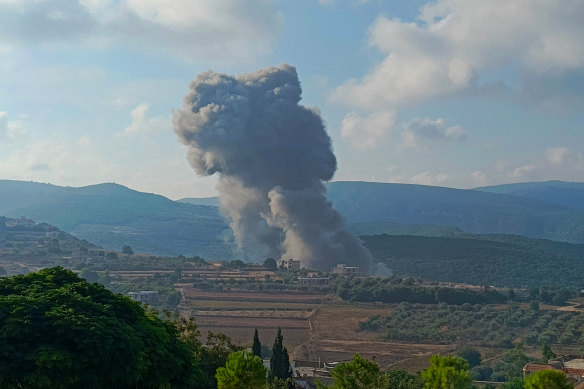
“There can be stages,” cautioned Ehud Yaari, an Israel-based fellow of the Washington Institute for Near East Policy, a research group. “You can have escalation that is gradual.”
Later Sunday morning, the Israeli military said it was continuing to strike Hezbollah launchers in southern Lebanon. Hezbollah is estimated to possess tens of thousands of rockets and a smaller number of more sophisticated, precise missiles.

Smoke billows from the site of an Israeli airstrike on Zibqin in southern Lebanon.Credit: AFP
And Iran, Hezbollah’s patron, still has an open account with Israel, blaming it for the assassination of Ismail Haniyeh, the political leader of its ally Hamas, while he was in Tehran, just hours after the killing of Shukur. Israel officially took responsibility for Shukr’s death but not for Haniyeh’s.
In broadcast remarks delivered at the start of a government meeting Sunday afternoon, Prime Minister Benjamin Netanyahu of Israel declared that the morning’s events were “not the end of the story.” But by then, life in Israel had largely returned to routine.
Based on intelligence, Israel took the decision to preempt Hezbollah’s attack on Sunday “but not to go beyond,” Yaari said. The targets that Israel struck were all less than 50 kilometres inside Lebanon, he said. Israel said they were focused on thwarting the threat to Israeli forces and civilians from Hezbollah’s arsenal of rockets and drones, not its wider assets or infrastructure.
Hezbollah, for its part, appears to be “signalling that it is done for now,” Yaari said. “At the same time, they are saying this was the first stage of retaliation, leaving open the option to do more, if they get a green light from the Iranians,” he added.
The events Sunday have raised the stakes for negotiators gathering in Cairo to try to advance a ceasefire and hostage-release deal for the ongoing war in the Gaza Strip. The United States is leading the push, along with Qatari and Egyptian mediators, for a deal that would end the 10-month conflict between Israel and Hamas, in the hope that such an agreement could help calm tensions in the region.
For months, Hezbollah and Israel had engaged in tit-for-tat cross-border clashes. Hezbollah began firing in solidarity with Hamas after last October’s Hamas-led assault on southern Israel prompted Israel to go to war in Gaza.
The exchanges between Israel and Hezbollah have grown in intensity in recent weeks, in what many analysts have described as a war of attrition.
Loading
An all-out war between Israel and Hezbollah would be devastating for both sides, experts say. Hezbollah’s rockets and missiles can reach much of Israel and could paralyse parts of the country for weeks or months.
But the group must weigh its desire for revenge against the risks of a backlash at home in Lebanon, which is mired in political and economic turmoil.
Israel has long been readying for a war in Lebanon and is probably much better prepared than it was on its southern front, where Hamas took it by surprise in October.
Netanyahu said Israeli forces destroyed thousands of Hezbollah’s short-range rockets on Sunday and intercepted a swarm of drones that he said Hezbollah had launched at a strategic target in the centre of the country.
Tens of thousands of residents of the towns and villages on both sides of Israel’s border with Lebanon have been displaced from their homes for nearly 10 months.
“This is an additional step in changing the situation in the north and returning our residents securely to their homes,” Netanyahu said of Sunday’s actions. But no date has been set for their return.
This article originally appeared in The New York Times.









 Add Category
Add Category